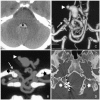Acute subarachnoid hemorrhage in posterior condylar canal dural arteriovenous fistula: imaging features with endovascular management
- PMID: 24990846
- PMCID: PMC4091406
- DOI: 10.1136/bcr-2014-011273
Acute subarachnoid hemorrhage in posterior condylar canal dural arteriovenous fistula: imaging features with endovascular management
Abstract
A 43-year-old man presented with acute subarachnoid hemorrhage. He was investigated and found to have a rare posterior condylar canal dural arteriovenous fistula (DAVF). DAVFs of the posterior condylar canal are rare. Venous drainage of the DAVF was through a long, tortuous, and aneurysmal bridging vein. We describe the clinical presentation, cross sectional imaging, angiographic features, and endovascular management of this patient. The patient was treated by transarterial embolization of the fistula through the ascending pharyngeal artery. This is the first report of an acutely bled posterior condylar canal DAVF treated by transarterial Onyx embolization with balloon protection in the vertebral artery. The patient recovered without any neurological deficit and had an excellent outcome. On 6 month follow-up angiogram, there was stable occlusion of the dural fistula.
Keywords: Balloon; CT Angiography; Fistula; Hemorrhage; Liquid Embolic Material.
2014 BMJ Publishing Group Ltd.
Figures




Similar articles
-
Endovascular embolisation of posterior condylar canal dural arteriovenous fistula.BMJ Case Rep. 2024 Feb 15;17(2):e258375. doi: 10.1136/bcr-2023-258375. BMJ Case Rep. 2024. PMID: 38359960
-
Acute subarachnoid hemorrhage in posterior condylar canal dural arteriovenous fistula: imaging features with endovascular management.J Neurointerv Surg. 2015 Jul;7(7):e26. doi: 10.1136/neurintsurg-2014-011273.rep. Epub 2014 Jul 8. J Neurointerv Surg. 2015. PMID: 25006042
-
Management of a rare case of posterior condylar canal dural arteriovenous fistula presenting with subarachnoid haemorrhage: A case report and review of literature.Interv Neuroradiol. 2018 Apr;24(2):206-209. doi: 10.1177/1591019917743703. Epub 2017 Dec 3. Interv Neuroradiol. 2018. PMID: 29199500 Free PMC article. Review.
-
Endovascular treatment of posterior condylar canal dural arteriovenous fistula.BMJ Case Rep. 2016 May 31;2016:bcr2016012384. doi: 10.1136/bcr-2016-012384. BMJ Case Rep. 2016. PMID: 27247204 Free PMC article.
-
Dural arteriovenous fistulas of the hypoglossal canal: systematic review on imaging anatomy, clinical findings, and endovascular management.J Neurosurg. 2015 Apr;122(4):883-903. doi: 10.3171/2014.10.JNS14377. Epub 2014 Nov 21. J Neurosurg. 2015. PMID: 25415064
Cited by
-
Endovascular embolisation of posterior condylar canal dural arteriovenous fistula.BMJ Case Rep. 2024 Feb 15;17(2):e258375. doi: 10.1136/bcr-2023-258375. BMJ Case Rep. 2024. PMID: 38359960
-
Multiple Dural Arteriovenous Fistulas Manifesting as Progressive Otalgia and Tinnitus and Treated Using a Single Session of Endovascular Embolization.Clin Interv Aging. 2020 Dec 8;15:2313-2320. doi: 10.2147/CIA.S277762. eCollection 2020. Clin Interv Aging. 2020. PMID: 33335390 Free PMC article.
-
Endovascular Treatment of Dural Arteriovenous Fistulas of the Anterior or Posterior Condylar Vein : A Cadaveric and Clinical Study and Literature Review.Clin Neuroradiol. 2019 Jun;29(2):341-349. doi: 10.1007/s00062-018-0669-1. Epub 2018 Feb 5. Clin Neuroradiol. 2019. PMID: 29404621 Free PMC article.
References
-
- Martins C, Yasuda A, Campero A, et al. Microsurgical anatomy of the dural arteries. Neurosurgery 2005;56(Suppl 2):211–51 - PubMed
-
- Mitsuhashi Y, Aurboonyawat T, Pereira VM, et al. Dural arteriovenous fistulas draining into the petrosal vein or bridging vein of the medulla: possible homologs of spinal dural arteriovenous fistulas. Clinical article. J Neurosurg 2009;111:889–99 - PubMed
Publication types
MeSH terms
LinkOut - more resources
Full Text Sources
Other Literature Sources
